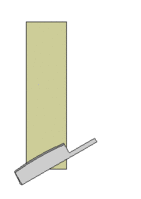Very excited. Just arrived today. Been researching this and talking with Jarrod about this, for months now.
You can see a bit of light at each outside end, which proves the convexity.
The light, mottled side is the soft bevel setter. (although at 2.5, the "soft" is super dense).
The black translucent is the finisher.
Both sides convexed by Jarrod on his concave granite plate. Check out videos at TSS.
Honing oil is water mixed with Ballistol.
Now let the conversations begin about this new system.
The idea is that since the convexity makes it fast, you can go from bevel setter all the way to the end, just by using the finisher.
I will report back.







You can see a bit of light at each outside end, which proves the convexity.
The light, mottled side is the soft bevel setter. (although at 2.5, the "soft" is super dense).
The black translucent is the finisher.
Both sides convexed by Jarrod on his concave granite plate. Check out videos at TSS.
Honing oil is water mixed with Ballistol.
Now let the conversations begin about this new system.
The idea is that since the convexity makes it fast, you can go from bevel setter all the way to the end, just by using the finisher.
I will report back.



